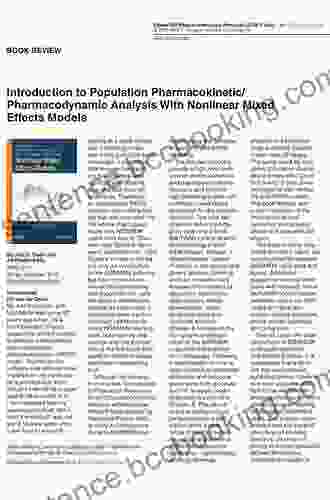Introduction to Population Pharmacokinetic-Pharmacodynamic Analysis: Unveiling the Interplay of Drugs and the Human Body

: The Cornerstone of Drug Development and Optimization
Population Pharmacokinetic-Pharmacodynamic (PK-PD) Analysis stands as a cornerstone of modern drug development and optimization. It encompasses the intricate study of how drugs interact with the human body, shedding light on their absorption, distribution, metabolism, and excretion (pharmacokinetics) as well as their impact on physiological responses (pharmacodynamics).
5 out of 5
| Language | : | English |
| File size | : | 19078 KB |
| Text-to-Speech | : | Enabled |
| Screen Reader | : | Supported |
| Enhanced typesetting | : | Enabled |
| Print length | : | 306 pages |
| Lending | : | Enabled |
Leveraging advanced statistical and mathematical techniques, PK-PD Analysis empowers researchers and pharmaceutical scientists to decipher the complex relationships between drug exposure and its effects. This invaluable knowledge enables the tailoring of drug therapies to individual patient characteristics, maximizing their efficacy while minimizing adverse reactions.
Chapter 1: Delving into the Concepts of Pharmacokinetics and Pharmacodynamics
This chapter introduces the fundamental concepts of pharmacokinetics and pharmacodynamics, laying the groundwork for understanding PK-PD Analysis. Readers will explore key principles such as drug absorption, distribution, metabolism, and elimination, gaining insights into how drugs move through the body.
Furthermore, the chapter delves into the realm of pharmacodynamics, examining how drugs interact with their target receptors and elicit physiological responses. By understanding these fundamental concepts, readers can appreciate the interplay between drug exposure and its effects.
Chapter 2: Unveiling the Power of Population Modeling
Chapter 2 unveils the power of population modeling, a statistical approach that forms the backbone of PK-PD Analysis. Readers will learn the intricacies of population modeling, including the estimation of population parameters and the characterization of inter-individual variability.
Through real-world examples, the chapter demonstrates how population modeling can identify factors influencing drug disposition and response, enabling researchers to develop more personalized and effective drug regimens.
Chapter 3: Mechanistic Insight through Pharmacodynamic Modeling
This chapter delves into the realm of pharmacodynamic modeling, a vital tool for understanding the relationship between drug exposure and its effects. Readers will explore different pharmacodynamic models, each capturing specific aspects of drug-response relationships.
By applying pharmacodynamic modeling, researchers can elucidate the mechanisms of drug action, predict drug effects, and optimize dosing strategies. The chapter also covers advanced topics such as model selection, validation, and sensitivity analysis.
Chapter 4: Applications in Drug Development and Beyond
Chapter 4 explores the multifaceted applications of PK-PD Analysis throughout the drug development process. Readers will gain insights into its role in dose selection, optimizing clinical trial designs, and evaluating drug-drug interactions.
Beyond drug development, PK-PD Analysis finds applications in precision medicine, personalized dosing, and the evaluation of drug safety and efficacy. This chapter showcases the versatility of PK-PD Analysis as a powerful tool in various healthcare settings.
Chapter 5: Embracing Emerging Technologies
The concluding chapter peers into the future of PK-PD Analysis, exploring emerging technologies that are revolutionizing the field. Readers will discover the potential of artificial intelligence, machine learning, and systems biology to enhance PK-PD modeling accuracy and predictive capabilities.
This chapter highlights the ongoing advancements in PK-PD Analysis and provides a glimpse into the future of drug development and optimization.
: Empowering Drug Development and Patient Care
Population Pharmacokinetic-Pharmacodynamic Analysis has emerged as an indispensable tool in drug development and patient care, enabling the optimization of drug therapies and the enhancement of patient outcomes. This comprehensive guide has provided an in-depth exploration of the concepts, methodologies, and applications of PK-PD Analysis, empowering readers to harness its potential.
By embracing the principles and techniques outlined in this guide, researchers, pharmaceutical scientists, and healthcare professionals can continue to revolutionize drug development and deliver personalized, effective, and safe drug therapies to patients worldwide.
5 out of 5
| Language | : | English |
| File size | : | 19078 KB |
| Text-to-Speech | : | Enabled |
| Screen Reader | : | Supported |
| Enhanced typesetting | : | Enabled |
| Print length | : | 306 pages |
| Lending | : | Enabled |
Do you want to contribute by writing guest posts on this blog?
Please contact us and send us a resume of previous articles that you have written.
 Book
Book Novel
Novel Page
Page Chapter
Chapter Text
Text Story
Story Genre
Genre Reader
Reader Library
Library Paperback
Paperback E-book
E-book Magazine
Magazine Newspaper
Newspaper Paragraph
Paragraph Sentence
Sentence Bookmark
Bookmark Shelf
Shelf Glossary
Glossary Bibliography
Bibliography Foreword
Foreword Preface
Preface Synopsis
Synopsis Annotation
Annotation Footnote
Footnote Manuscript
Manuscript Scroll
Scroll Codex
Codex Tome
Tome Bestseller
Bestseller Classics
Classics Library card
Library card Narrative
Narrative Biography
Biography Autobiography
Autobiography Memoir
Memoir Reference
Reference Encyclopedia
Encyclopedia John Graham
John Graham Jim Ziolkowski
Jim Ziolkowski Neil Wilson
Neil Wilson Jitender Singh
Jitender Singh Terence Smith
Terence Smith Joe Musser
Joe Musser John Fabian Carlson
John Fabian Carlson John Boyko
John Boyko Michael Phelps
Michael Phelps John Gilstrap
John Gilstrap Jo Weldon
Jo Weldon Yatir Nitzany
Yatir Nitzany Kay Thompson
Kay Thompson John Dvorak
John Dvorak Natasha Newton
Natasha Newton Michael Cirillo
Michael Cirillo Johannes Brahms
Johannes Brahms Michael K Deaver
Michael K Deaver Lola Wright
Lola Wright John Bosco
John Bosco
Light bulbAdvertise smarter! Our strategic ad space ensures maximum exposure. Reserve your spot today!

 Leo MitchellLethal Game: A Heart-Pounding Thriller that Will Keep You on the Edge of Your...
Leo MitchellLethal Game: A Heart-Pounding Thriller that Will Keep You on the Edge of Your... Devin RossFollow ·5.5k
Devin RossFollow ·5.5k Richard SimmonsFollow ·9.6k
Richard SimmonsFollow ·9.6k Floyd RichardsonFollow ·18.5k
Floyd RichardsonFollow ·18.5k Ralph Waldo EmersonFollow ·9k
Ralph Waldo EmersonFollow ·9k Isaiah PowellFollow ·13.5k
Isaiah PowellFollow ·13.5k Haruki MurakamiFollow ·8k
Haruki MurakamiFollow ·8k Harvey BellFollow ·18.7k
Harvey BellFollow ·18.7k Lee SimmonsFollow ·6k
Lee SimmonsFollow ·6k

 Jesus Mitchell
Jesus MitchellDiscover the World of Satisfying Meals with Or...
In a world where culinary creations often...

 Darius Cox
Darius CoxJourney into the Extraordinary Life of Kublai Khan: An...
Immerse Yourself in the Fascinating...

 Gil Turner
Gil TurnerThe Fourth Industrial Revolution: The Precariat and the...
In his groundbreaking book, The Fourth...

 Jonathan Franzen
Jonathan FranzenGenghis Khan: His Heirs and the Founding of Modern China
Genghis Khan, the...

 Eugene Powell
Eugene PowellJourney Through the Golden Age of the Ottoman Empire with...
Delve into the Enchanting World of the...
5 out of 5
| Language | : | English |
| File size | : | 19078 KB |
| Text-to-Speech | : | Enabled |
| Screen Reader | : | Supported |
| Enhanced typesetting | : | Enabled |
| Print length | : | 306 pages |
| Lending | : | Enabled |












